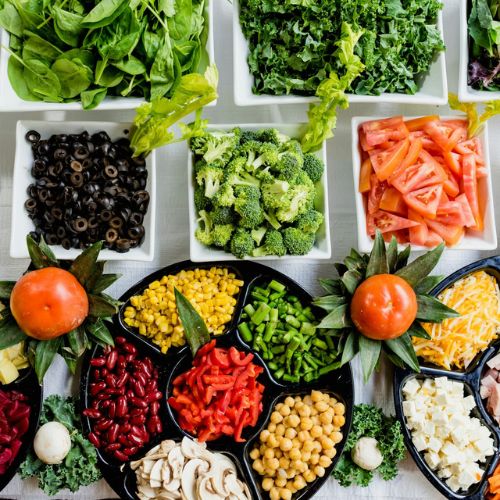Ever walked past a vegan restaurant, glanced at the menu and wondered why the prices are higher than your local eatery?
Stick around and we’ll uncover some surprising reasons behind the cost of eating plant-based.
1. The Cost of Fresh, Quality Ingredients

First things first, vegan restaurants often use fresh, high-quality ingredients.
While some eateries rely on processed foods, many vegan joints pride themselves on using organic, locally sourced produce and not much processed foods.
Organic farming tends to be more labour-intensive and expensive due to lower yields and higher production costs. Buying locally often means supporting smaller farms, which can also increase prices.
Vegan restaurants also frequently use exotic ingredients not commonly found in typical restaurants.
The commitment to using the best, freshest ingredients means the cost is reflected in the menu prices.
2. Specialised Ingredients Aren’t Cheap

Ever tried making a vegan cheesecake?
It’s not just swapping cream cheese for tofu. Vegan dishes often require specialised ingredients like nutritional yeast, tempeh or cashew cheese, which aren’t always readily available at your local supermarket.
Think of superfoods like spirulina, goji berries and hemp seeds. These ingredients are not only packed with nutrients but also come with a hefty price tag.
These ingredients can be pricier and more challenging to source, contributing to higher menu prices.
In addition to specialised vegan substitutes, many vegan restaurants offer gluten-free, soy-free, or nut-free options to accommodate various dietary restrictions.
This inclusivity means they must source more specific ingredients, which can add to the overall cost. It’s all about providing a versatile menu that meets diverse needs and this versatility doesn’t come cheap.
3. Preparation Takes Time and Time is Money

Creating vegan dishes is often a more intricate process. Chopping, blending and marinating are necessary to bring out the best flavours in plant-based foods.
This extra labour in the kitchen translates to higher costs. Chefs in vegan restaurants are often more skilled and knowledgeable about nutrition – adding value to your meal and a few pounds to your bill.
Cooking without animal products requires creativity and expertise!
Transforming simple vegetables into gourmet dishes involves advanced cooking techniques and a deep understanding of flavour profiles. This craftsmanship takes time, effort and training, which is reflected in the price you pay.
4. Sustainable Practices Come at a Price

Many vegan restaurants are committed to sustainability, which is fantastic for the planet! But wait — it adds to the cost. They might use eco-friendly packaging, source fair-trade ingredients or pay their staff a living wage.
These ethical choices are commendable but can lead to higher prices than places that cut corners to save costs.
Using biodegradable or compostable packaging instead of plastic is more expensive. Similarly, fair-trade ingredients ensure farmers receive a higher price than conventional market prices.
5. Smaller Market, Higher Costs

The vegan restaurant market is still relatively niche.
With fewer customers than mainstream restaurants, vegan eateries might not benefit from the same economies of scale.
This means they can’t buy ingredients in bulk at discounted rates, leading to higher costs passed on to the customer.
This smaller customer base also means vegan restaurants often operate in smaller, boutique settings rather than large chains.
Smaller venues can have higher overheads per customer, which the menu prices must cover. It’s a trade-off between quality and quantity.
6. Healthy Food Options Cost More

Eating vegan often means eating healthier.
Vegan meals are typically lower in cholesterol and saturated fats and can contain nutrients. You’re not just paying for a meal but investing in your health. This health boost comes with a price tag, but many find it worthwhile for the long-term benefits.
Vegan diets are linked to lower risks of chronic diseases, better weight management and improved overall well-being.
The health benefits are significant and paying a bit more for your meal is a small price for a longer, healthier life. Plus, many vegan restaurants offer dishes rich in antioxidants, vitamins and minerals, adding to their appeal.
Suggested read: 24 Expensive Vegan Ingredients That Are Worth The Splurge
7. Innovative Cuisine Takes Creativity

Vegan chefs are often culinary innovators, creating dishes that surprise and delight with every bite.
This innovation requires creativity and experimentation, leading to unique, flavourful dishes you won’t find anywhere else. The artistry involved in creating these dishes adds value and cost.
Think of dishes like beetroot carpaccio, jackfruit tacos or cauliflower steak. These aren’t your everyday meals and require a lot of trial and error to perfect.
The result is a unique and memorable dining experience that justifies the higher price. You’re not just paying for food; you’re paying for a culinary adventure.
8. High Demand for Plant-Based Diets
As the demand for vegan food grows, so does the price.
More people are adopting plant-based diets for health, environmental or ethical reasons. This increasing demand can lead to higher prices, especially in trendy, urban areas where vegan restaurants are popping up faster than ever.
Urban vegan hotspots like London, Brighton and Manchester see a higher influx of vegan and health-conscious diners.
The popularity and high demand in these areas mean restaurants can afford higher prices, knowing that a steady stream of customers are willing to pay for quality vegan food.
9. Supporting Ethical Business Practices

By dining at vegan restaurants, you support businesses that often align with ethical practices. This support extends beyond the food to fair wages and community engagement.
These values come at a price but contribute to a better world.
Ethical business practices might include sourcing from local farms and engaging in community outreach programmes.
Your meal price reflects these values, supporting a business model prioritising people over profit.
The Bottom Line: It’s About Value, Not Just Cost
While vegan restaurants might be pricier, the reasons behind these costs are often rooted in quality, sustainability and ethical practices.
These factors contribute to the overall value of your dining experience, making it a worthwhile investment. So, go ahead and treat yourself to that vegan burger or smoothie bowl. You deserve it!

It’s refreshing to see an article addressing the real costs behind sustainable practices in the food industry. Sustainability isn’t just a buzzword but a necessary commitment to our planet.
Sustainable practice stuff sounds good and all but how does it affect the taste? doesnt it mean more expensive food?
Actually, sustainable practices often lead to better quality and taste since the ingredients are fresher and grown without harmful chemicals. Yes, it might be slightly more costly, but the benefits outweigh the price.
While I appreciate the effort to justify high prices with ‘sustainability’ and ‘quality’, let’s not pretend that this isn’t also a fantastic way for businesses to pad their margins. Gourmet buzzwords can often lead to gourmet profits.
interesting read about how tech and food world kinda intersect with sustainability and all that jazz. makes u think bout where your food comes from
Your point on the challenges associated with sourcing specialised ingredients is spot on. The logistics and costs involved often go unnoticed by the average consumer.
prep time totally gets overlooked when ppl talk about food costs. good on you for highlighting it, takes me ages to get everything just right when im in the kitchen.
Ah yes, the ‘innovative cuisine’ line. Because nothing screams innovation like charging ten quid for a salad because it has some exotic berry in it. Creativity indeed.
High demand for plant-based diets is a hopeful sign for both our health and the environment. This surge in interest propels much-needed innovation in the food industry.
Supporting ethical business practices sounds great on paper, but how many actually stick to their guns when profits are on the line? Colour me sceptical.
Smaller market, higher costs – a reality often ignored by many. The dedication to quality over quantity deserves recognition and support. Well said…